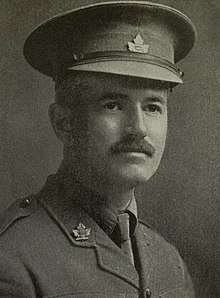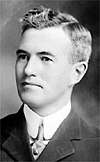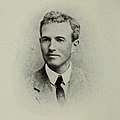George Harold Baker
George Harold Baker (November 4, 1877 – June 2, 1916) was a lawyer, political figure, and soldier from Quebec, Canada. He represented Brome in the House of Commons of Canada from 1911 to 1916 as a Conservative Member of Parliament.
George Harold Baker | |
|---|---|
 Baker in uniform at Valcartier (July 1915) | |
| Member of Parliament for Brome | |
| In office September 21, 1911 – June 2, 1916 | |
| Preceded by | Sydney A. Fisher |
| Succeeded by | Andrew Ross McMaster |
| Personal details | |
| Born | November 4, 1877 Sweetsburg, Quebec, Canada |
| Died | June 2, 1916 (aged 38) Mount Sorrel, Ypres Salient, Belgium |
| Cause of death | Killed in action |
| Political party | Conservative |
| Relations | George Barnard Baker, father |
| Alma mater | McGill University |
| Profession | Lawyer, soldier |
| Military service | |
| Allegiance | |
| Branch/service | Canadian Army |
| Years of service | 1903 - 1916 |
| Rank | Lieutenant Colonel |
| Unit | 6th Hussars 13th Scottish Light Dragoons 5th Battalion, Canadian Mounted Rifles, CEF |
| Battles/wars | World War I
|
He is the only sitting Canadian MP to be killed in action on military service.
Early life
He was born in Sweetsburg, Quebec, the son of George Barnard Baker, a Member of Parliament and Senator.
Prior to the First World War, Baker served as a member of the 6th Hussars and the 13th Scottish Light Dragoons.
Political career
Baker was elected as the Member of Parliament for Brome in the 1911 federal election, representing the Conservative Party.

| 1911 Canadian federal election | ||||||||
|---|---|---|---|---|---|---|---|---|
| Party | Candidate | Votes | ||||||
| Conservative | George Harold Baker | 1,520 | ||||||
| Liberal | Sydney Arthur Fisher | 1,496 | ||||||
First World War
Baker fought in World War I as a Lieutenant-Colonel, commanding the 5th Canadian Mounted Rifles. He was killed in action at Wieltje Salient, West Flanders, Belgium on June 2, 1916, during the Battle of Mount Sorrel. Baker was carried out of the action by his second-in-command Major Dennis Draper.[1] He was buried at Poperinghe New Military Cemetery, where his gravestone bears the inscription: DEATH IS A LOW MIST WHICH CANNOT BLOT THE BRIGHTNESS IT MAY VEIL.[2][3]
Baker's life and death were commemorated by the publication of A Canadian Soldier (1917).[1][4] A memorial service was held at Christ Church in Sweetsburg, Quebec, on June 18, 1916. Tributes were paid by the Reverend W. P. R. Lewis and General Sir Sam Hughes, Minister of Militia. Baker's death was also marked by the Prime Minister of Canada Sir Robert Borden, with a statement published in the press and a further tribute given at the opening of parliament on January 18, 1917.[1]
A bronze memorial statue to Baker by R. Tait McKenzie was unveiled on February 29, 1924 by Governor General Lord Byng in the House of Commons foyer in the Centre Block building of the Parliament of Canada in Ottawa, Canada.[5] The Prime Minister of Canada William Lyon MacKenzie King spoke at the unveiling, and his speech and those of others were recorded in the red leather-bound commemorative volume Parliamentary Memoir of George Harold Baker, M.P. (1924). This volume also included a funerary poem for Baker: "Non Mortuus".[6]
The base of the memorial statue bears the following inscription:
LIEUT-COLONEL GEORGE HAROLD BAKER, M.P., 5th C.M.R. KILLED IN ACTION, JUNE 2, 1916, AT THE BATTLE OF SANCTUARY WOOD. ERECTED BY ORDER OF THE PARLIAMENT OF CANADA.[7]
Either side of the recess holding the memorial statue, there are inscriptions on the walls. The inscription to the left is a biblical quote (2 Maccabees 6.31)[8][9] and the inscription to the right is the final five lines of the poem "In Flanders Fields" by John McCrae.[6][10]
 Glenmere, East Bolton, September 1911
Glenmere, East Bolton, September 1911 Camp Valcartier, July 1915
Camp Valcartier, July 1915 Baker's grave in Belgium
Baker's grave in Belgium Baker memorial statue
Baker memorial statue
References
- Cunliffe, John William (1917). A Canadian Soldier (pdf). New York: University Printing Office, Columbia University. p. 67.
- This epitaph is a quote from Percy Bysshe Shelley's Adonaïs (1821), an elegy for John Keats.
- "Casualty Details: Baker, George Harold". Commonwealth War Graves Commission. Retrieved 25 January 2018.
- This work was written by John William Cunliffe (1865–1946) of Columbia University, New York, USA. The memorial volume contains a brief biography, several pages of letters written by Baker and others in the war, some photographs, contemporary newspaper reports and official accounts of the battle in which Baker died, and reports of tributes paid to Baker.
- Monaghan, David (October 2012). "The Baker Memorial". Parliament of Canada. Retrieved 22 January 2018.
- Bentley, D. M. R. (Spring–Summer 1993). "Monumentalités". Canadian Poetry. Canadian Poetry Press. 32.
- "Lieutenant-Colonel George Harold Baker". Parliament of Canada. Retrieved 25 January 2018.
- The Maccabees inscription uses the wording from the King James Version of the bible: AND THUS THIS MAN DIED LEAVING HIS DEATH FOR AN EXAMPLE OF A NOBLE COURAGE AND A MEMORIAL OF VIRTUE NOT ONLY UNTO YOUNG MEN BUT UNTO ALL HIS NATION.
- "2 Maccabees 6:31". King James Bible Online. Retrieved 25 January 2018.
- The McCrae inscription is as follows: TO YOU FROM FAILING HANDS WE THROW THE TORCH BE YOURS TO HOLD IT HIGH IF YE BREAK FAITH WITH US WHO DIE WE SHALL NOT SLEEP THOUGH POPPIES BLOW IN FLANDERS FIELDS.
External links
| Wikimedia Commons has media related to George Harold Baker. |
- A Canadian soldier: George Harold Baker, M.P. (1917) by J. W. Cunliffe
- The Immortalized (Colonels of the Canadian Expeditionary Force)
- George Harold Baker's military service record (Library and Archives Canada)
- George Harold Baker (Canadian Virtual War Memorial)
- Morning Glory: Canada's own WWI war horse (CBC News)
- Monday Monuments and Memorials – Lt Col George Harold Baker, MP and Morning Glory (Great War 100 Reads)